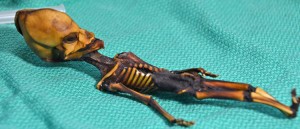The Mystery of Ata
April 10, 2018
Last month, in March, scientists published results of a DNA study on an ancient, mysterious, and rather alien-looking skeleton found in the Atacama Desert of Chile. Some people claimed the well-preserved skeleton, only about 6 inches (15 centimeters) long with an an elongated skull and other unusual features, was proof that aliens exist and have visited Earth. The study, however, published in the journal Genome Research, showed that the skeleton (known as Ata for Atacama) was in fact that of an infant human. The unusual skeleton is quite real, however, and the study explained the skeleton’s extraterrestrial appearance.

This mummified skeleton from the Atacama Desert in Chile had been described as “alien.” Genetic analysis showed that the skeleton was human and may have had a previously unknown bone disorder. Credit: © Emery Smith
Ata’s remains were discovered in 2003 at La Noria, an abandoned saltpeter-mining town in northern Chile. Ata eventually passed to a private collector. The tiny skeleton is remarkable in many ways. Ata has an unusual elongated, cone-shaped head and possesses only 10 pairs of ribs instead of the 12 pairs normally found in humans. The skeleton looked to be about the size of a human infant, yet the bones were remarkably well developed, more like those of a child perhaps 6 years old.
Ata’s shocking features fueled wild speculation about the skeleton’s origins. Some considered it an obvious fraud, perhaps the skeleton of a monkey that had been altered for a side show attraction. Historically, such hoaxes were created by circuses or side-shows to fool gullible patrons. Other people thought the skeleton belonged to a human child suffering from an unknown, perhaps genetic, malady. However, a few people pointed out physical similarities to reported alien visitors and suggested that the skeleton was evidence alien astronauts had visited that region of South America centuries ago.
Beginning in 2012, scientists at the Stanford University School of Medicine in California conducted studies in an attempt to solve the mystery of Ata. They initially identified the skeleton as unquestionably human. The skeleton appeared ancient, although scientists could not determine exactly how old it was. Explaining the skeleton’s size and many unusual features proved more difficult. The scientists simply had never seen a skeleton quite like this before. Only after colleagues at the University of California in San Francisco examined Ata’s genetic material was the mystery solved.
The scientists were able to extract Ata’s complete genome from the bones. A genome is the entire set of genes that control heredity in a human being. The genetic material confirmed that Ata was a female and closely related to the native peoples of Chile—thus not an alien. The scientists also found that Ata suffered from a variety of genetic mutations that created her highly unusual features. The researchers identified at least seven mutated genes that are known to cause significant skeletal malformation in humans. Some of the genes are known to cause dwarfism and scoliosis, an abnormal curvature of the spine, as well as other, less common deformities.
The severity of the genetic mutations unfortunately meant that Ata most likely died soon after birth. Some of her mutated genes are involved in skeletal maturation, making her bones appear older than her actual age. When discovered, her remains were reportedly wrapped in a white cloth tied with a purple ribbon. Although her life was tragically short, Ata was cared for by her family and given a loving funeral.
After the genetic study was published, officials in Chile protested that the researchers had violated ethical guidelines concerning the treatment of human remains. The National Monuments Council of Chile began an investigation to determine if Ata’s remains were illegally exhumed (dug up) and exported from the country. In Chile, the government has passed laws intended to protect graves and human remains as well as other cultural items of importance to Native Americans. These laws are similar to the Native American Graves Protection and Repatriation Act (NAGPRA) in the United States. NAGPRA makes it illegal to buy, sell, or transport for sale any Native American human remains or other cultural items. Chilean officials claim that American researchers violated the law by conducting the study on Ata’s remains without proper permission.


